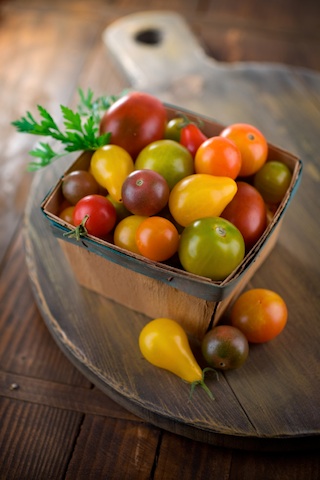
One of the pleasures of growing your own food is having a change to try heirloom varieties. These pear and cherry tomatoes do not travel well but have amazing flavor. You wont find these tomatoes at a grocery store but your local farmer's market will have them in season.
This is a post I wrote back in early October. It is quite a contrast from today, since we are pulling out our winter boots, snow pants and jackets after the first snow of the year:
Shaen and I spent the afternoon working at cutting back the tomato plants. We removed leaves and extra green growth from the tomato plants in an attempt to encourage the plant to put its energy into ripening the tomatoes before the first killer frost. Shaen found a monster eggplant and numerous hot peppers hiding in the greenhouse. Sonja worked on pulling up beets and baby carrots. Erika found a potato plant and dug up the tubers. Erika danced through the garden collecting ripe cherry tomatoes like some sort of fairy nymph. The girls cleaned and processed their vegetables.
For dinner, I made a mixture of baked vegetables in a glass baking dish. Most of the vegetables came from Farmhouse Herbs an organic farm that sells at the Kamloops Farmer’s Market. It hasn’t been a good year for our garden and Farmhouse Herbs has supplied my household with much of our vegetables. The vegetables included: parsnips, onions, green onion tops, garlic, beets and carrots. (By the way, those golden beets were the best beets I have ever eaten.) I added herbs gathered by the garden nymph, and mixed in sea salt and fat from my grease bucket. Please read The Great Grease Bucket: Something for Nothing for more information. In another glass baking dish, I cut the freshly dug potatoes and added sea salt and fat. I used our own garden carrots, lightly cooked in butter and dressed with fresh garden parsley.
When Shaen came in at the end of the day, he cooked three chuck steaks on the barbecue. Chuck steak is normally not grilled because it is considered a tough cut of meat but these steaks were tender and very juicy. We got the grassfed veal from Jocko Creek Ranch last winter. For more information please read Grassfed Veal and Cooking With Grass-Fed Meat and Fowl.
When we sat down to our meal, we each enjoyed a glass of fresh cow’s milk. There was a salad of sun ripened cherry tomatoes and herbs. The girls loaded their potatoes with raw butter I made last year. (I privately thanked Patty, our Jersey cow, for the wonderful dairy products.) It was a delicious meal. The meal was wonderful because so much of the food came from our own land or from the land of people we know and trust. We were hungry after working the afternoon in the garden. What also made the meal special is that we ate it together and enjoyed each other’s company.
I just wanted to tell about one sit-down family meal. It wasn’t a special meal but the way we eat normally. This meal might seem odd to the modern eater, rushing between the office, take-out, and home but this meal would have been the norm a generation ago.
Oven Baked Seasonal Vegetables
4-6 large carrots, cut into large 3″ pieces
4-6 parsnips, cut into large 3″ pieces
2 orange beets or turnips, cut into wedges
1 large onion, cut into wedges
1-2 leek tops, cut into large 3″ pieces
2-3 large garlic cloves, cut in half
1T fresh rosemary, chopped
1tsp sea salt
1tsp fresh growing black pepper
1T grease from the grease bucket
1-2 potatoes, cut into wedges, optional
The trick to this meal is to use the best seasonal vegetables you can find. Cut all the vegetables into pieces about the same size so they will cook evenly. Use a large glass baking dish and mix all the cut vegetables together with the grease, black pepper, sea salt and rosemary. Cook at 350F and stir every 15 minutes for about 45 minutes or until the vegetables are cooked through.
Sun Ripened Tomato Salad
2-3c sun ripened cherry tomatoes, whole
1/2c garden parsley, finely chopped
1/4c red onion, finely chopped (optional)
Add all ingredients together in a wooden salad bowl. Add 2-3T of Whole Seed Mustard Dressing. The recipe can be found in Making Homemade Lacto-Fermentation Whole Seed Mustard.
Hey farmer farmer
Put away the DDT now
Give me spots on my apples
But leave me the birds and the bees
Please!
Don’t it always seem to go
That you don’t know what you’ve got
Till it’s gone
They paved paradise
And put up a parking lot
Big Yellow Taxi by Joni Mitchell
